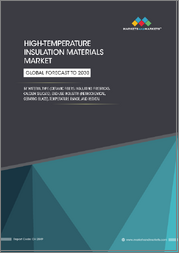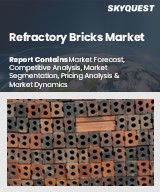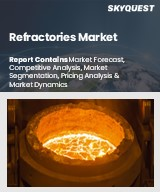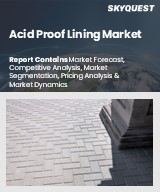
|
시장보고서
상품코드
1670148
오염 흡수 벽돌 시장 규모, 점유율, 성장 분석 : 제품 유형별, 용도별, 원재료별, 기술별, 최종사용자별, 지역별 - 산업 예측(2025-2032년)Pollution Absorbing Bricks Market Size, Share, and Growth Analysis, By Product Type, By Application, By Raw Material, By Technology, By End User, By Region - Industry Forecast 2025-2032 |
||||||
오염 흡수 벽돌 2023년 시장 규모는 51억 7,000만 달러로, 2024년 55억 6,000만 달러에서 2032년에는 99억 1,000만 달러로 성장하며, 예측 기간(2025-2032년)의 CAGR은 7.5%로 성장할 전망입니다.
환경 지속가능성에 대한 인식 증가와 정부의 적극적인 녹색 건축 실천을 촉진하는 노력으로 오염 흡수 벽돌 시장이 성장세를 보이고 있습니다. 이 특수 벽돌은 입자상 물질, VOC, NOx 등 대기 오염 물질을 효과적으로 저감하여 실내 공기질을 개선하고 주변 환경에 긍정적으로 기여합니다. 그 적용 범위는 주택, 상업용 건물, 산업용 건물, 공공 인프라에 이르기까지 다양하며, 신축 및 개보수 프로젝트에도 적용이 가능합니다. 제조업체들이 혁신적인 첨단 기술을 개발함에 따라 이러한 지속가능한 건축자재에 대한 수요는 지속적으로 증가하고 있으며, 이는 환경 친화적인 건축 솔루션에 대한 광범위한 추세를 반영합니다. 미국의 오염 흡수 벽돌 시장은 향후 예측 기간 중에도 지속가능한 성장을 이룰 것으로 예상됩니다.
목차
서론
- 조사의 목적
- 조사 범위
- 정의
조사 방법
- 정보 조달
- 2차와 1차 데이터 방법
- 시장 규모 예측
- 시장의 전제조건과 제한
개요
- 세계 시장 전망
- 공급과 수요 동향 분석
- 부문별 기회 분석
시장 역학과 전망
- 시장 개요
- 시장 규모
- 시장 역학
- 촉진요인과 기회
- 억제요인과 과제
- Porter의 산업 분석
주요 시장 인사이트
- 주요 성공 요인
- 경쟁의 정도
- 주요 투자 기회
- 시장 에코시스템
- 시장의 매력 지수(2024년)
- PESTEL 분석
- 거시경제 지표
- 밸류체인 분석
- 가격 분석
- 사례 연구
- 규제 상황
- 고객과 구매 기준 분석
오염 흡수 벽돌 시장 규모 : 제품 유형별
- 시장 개요
- 표준 오염 흡수 벽돌
- 포장용 벽돌
- 내하중 벽돌
- 기타 오염 흡수 벽돌
오염 흡수 벽돌 시장 규모 : 용도별
- 시장 개요
- 주택
- 상업 빌딩
- 산업 빌딩
- 인프라 프로젝트
오염 흡수 벽돌 시장 규모 : 원재료별
- 시장 개요
- 점토
- 콘크리트
- 기타 원재료
오염 흡수 벽돌 시장 규모 : 기술별
- 시장 개요
- 압출 오염 흡수 벽돌
- 성형 오염 흡수 벽돌
- 기타 테크놀러지
오염 흡수 벽돌 시장 규모 : 최종사용자별
- 시장 개요
- 건설회사
- 건축가와 디자이너
- 개인 주택 소유주
- 정부
오염 흡수 벽돌 시장 규모
- 북미
- 미국
- 캐나다
- 유럽
- 독일
- 스페인
- 프랑스
- 영국
- 이탈리아
- 기타 유럽 지역
- 아시아태평양
- 중국
- 인도
- 일본
- 한국
- 기타 아시아태평양
- 라틴아메리카
- 브라질
- 기타 라틴아메리카 지역
- 중동 및 아프리카
- GCC 국가
- 남아프리카공화국
- 기타 중동 및 아프리카
경쟁 정보
- 상위 5사의 비교
- 주요 기업의 시장 포지셔닝(2024년)
- 주요 시장 기업이 채택한 전략
- 최근 시장 동향
- 기업의 시장 점유율 분석(2024년)
- 주요 기업의 기업 개요
- 기업의 상세
- 제품 포트폴리오 분석
- 기업의 부문별 점유율 분석
- 매출의 전년대비 비교(2022-2024)
주요 기업 개요
- Vandersanden Group(Belgium)
- Boral Limited(Australia)
- Wienerberger AG(Austria)
- CRH plc(Ireland)
- Ibstock Brick Limited(UK)
- Acme Brick Company(USA)
- General Shale Brick, Inc.(USA)
- Brickworks Limited(Australia)
- Michelmersh Brick Holdings PLC(UK)
- Austral Bricks(Australia)
- Hanson Building Products Limited(UK)
- Carolina Ceramics Brick Company(USA)
- Hebron Brick Company(USA)
- Taylor Clay Products, Inc.(USA)
- Brampton Brick Limited(Canada)
- Palmetto Brick Company(USA)
- Triangle Brick Company(USA)
- Redland Brick Inc.(USA)
- Endicott Clay Products Co.(USA)
결론과 제안
KSA 25.04.04Pollution Absorbing Bricks Market size was valued at USD 5.17 billion in 2023 and is poised to grow from USD 5.56 billion in 2024 to USD 9.91 billion by 2032, growing at a CAGR of 7.5% during the forecast period (2025-2032).
The market for pollution-absorbing bricks is gaining momentum due to heightened awareness of environmental sustainability and supportive government initiatives promoting green building practices. These specialized bricks effectively mitigate air pollutants such as particulate matter, VOCs, and NOx, enhancing indoor air quality and contributing positively to the surrounding environment. Their applicability spans residential, commercial, and industrial buildings, as well as public infrastructure, making them versatile for both new constructions and retrofit projects. As manufacturers innovate and develop advanced technologies, the demand for these sustainable construction materials continues to rise, reflecting a broader trend towards environmentally conscious building solutions. The US pollution-absorbing bricks market is projected to experience sustainable growth in the coming forecast period.
Top-down and bottom-up approaches were used to estimate and validate the size of the Pollution Absorbing Bricks market and to estimate the size of various other dependent submarkets. The research methodology used to estimate the market size includes the following details: The key players in the market were identified through secondary research, and their market shares in the respective regions were determined through primary and secondary research. This entire procedure includes the study of the annual and financial reports of the top market players and extensive interviews for key insights from industry leaders such as CEOs, VPs, directors, and marketing executives. All percentage shares split, and breakdowns were determined using secondary sources and verified through Primary sources. All possible parameters that affect the markets covered in this research study have been accounted for, viewed in extensive detail, verified through primary research, and analyzed to get the final quantitative and qualitative data.
Pollution Absorbing Bricks Market Segments Analysis
Global Pollution Absorbing Bricks Market is segmented by Product Type, Application, Raw Material, Technology, End User and region. Based on Product Type, the market is segmented into Standard Pollution Absorbing Bricks, Pavement Bricks, Load-Bearing Bricks and Other Pollution Absorbing Bricks. Based on Application, the market is segmented into Residential Buildings, Commercial Buildings, Industrial Buildings and Infrastructure Projects. Based on Raw Material, the market is segmented into Clay, Concrete and Other Raw Materials. Based on Technology, the market is segmented into Extruded Pollution Absorbing Bricks, Molded Pollution Absorbing Bricks and Other Technologies. Based on End User, the market is segmented into Construction Companies, Architects and Designers, Individual Homeowners and Government. Based on region, the market is segmented into North America, Europe, Asia Pacific, Latin America and Middle East & Africa.
Driver of the Pollution Absorbing Bricks Market
The increasing emphasis on eco-friendly construction materials that minimize environmental impact is driving the growth of the Pollution Absorbing Bricks market. These innovative bricks are becoming increasingly popular as sustainable building solutions due to their ability to enhance air quality. This aligns with the broader trend toward environmentally conscious construction practices, resulting in heightened demand for such materials. As builders and developers seek ways to reduce their carbon footprint and promote sustainability, pollution-absorbing bricks are emerging as a viable choice, thereby significantly contributing to the expansion of this market sector.
Restraints in the Pollution Absorbing Bricks Market
The pollution absorbing bricks market faces potential hurdles due to regulatory challenges and standards that could affect their widespread adoption. Manufacturers may encounter difficulties in adhering to various building codes, regulations, and standards associated with eco-friendly construction practices and indoor air quality requirements. These compliance issues can create obstacles for producers of pollution absorbing bricks, thereby impeding the growth and acceptance of this innovative building material in the market. Ultimately, navigating these regulatory landscapes can present significant challenges for manufacturers, limiting the potential expansion of the market for pollution absorbing bricks.
Market Trends of the Pollution Absorbing Bricks Market
The Pollution Absorbing Bricks market is experiencing significant growth driven by increasing government initiatives and regulatory frameworks promoting green building practices. As more countries prioritize sustainability, various incentives and certifications are being introduced to encourage the use of eco-friendly building materials. This trend is bolstered by rising public awareness regarding environmental issues and urban air quality, leading construction companies and architects to seek innovative solutions like pollution absorbing bricks. Consequently, the market is witnessing heightened demand, offering opportunities for manufacturers to innovate and expand their product lines in line with eco-conscious construction trends.
Table of Contents
Introduction
- Objectives of the Study
- Scope of the Report
- Definitions
Research Methodology
- Information Procurement
- Secondary & Primary Data Methods
- Market Size Estimation
- Market Assumptions & Limitations
Executive Summary
- Global Market Outlook
- Supply & Demand Trend Analysis
- Segmental Opportunity Analysis
Market Dynamics & Outlook
- Market Overview
- Market Size
- Market Dynamics
- Drivers & Opportunities
- Restraints & Challenges
- Porters Analysis
- Competitive rivalry
- Threat of substitute
- Bargaining power of buyers
- Threat of new entrants
- Bargaining power of suppliers
Key Market Insights
- Key Success Factors
- Degree of Competition
- Top Investment Pockets
- Market Ecosystem
- Market Attractiveness Index, 2024
- PESTEL Analysis
- Macro-Economic Indicators
- Value Chain Analysis
- Pricing Analysis
- Case Studies
- Regulatory Landscape
- Customer & Buying Criteria Analysis
Global Pollution Absorbing Bricks Market Size by Product Type & CAGR (2025-2032)
- Market Overview
- Standard Pollution Absorbing Bricks
- Pavement Bricks
- Load-Bearing Bricks
- Other Pollution Absorbing Bricks
Global Pollution Absorbing Bricks Market Size by Application & CAGR (2025-2032)
- Market Overview
- Residential Buildings
- Commercial Buildings
- Industrial Buildings
- Infrastructure Projects
Global Pollution Absorbing Bricks Market Size by Raw Material & CAGR (2025-2032)
- Market Overview
- Clay
- Concrete
- Other Raw Materials
Global Pollution Absorbing Bricks Market Size by Technology & CAGR (2025-2032)
- Market Overview
- Extruded Pollution Absorbing Bricks
- Molded Pollution Absorbing Bricks
- Other Technologies
Global Pollution Absorbing Bricks Market Size by End User & CAGR (2025-2032)
- Market Overview
- Construction Companies
- Architects and Designers
- Individual Homeowners
- Government
Global Pollution Absorbing Bricks Market Size & CAGR (2025-2032)
- North America (Product Type, Application, Raw Material, Technology, End User)
- US
- Canada
- Europe (Product Type, Application, Raw Material, Technology, End User)
- Germany
- Spain
- France
- UK
- Italy
- Rest of Europe
- Asia Pacific (Product Type, Application, Raw Material, Technology, End User)
- China
- India
- Japan
- South Korea
- Rest of Asia-Pacific
- Latin America (Product Type, Application, Raw Material, Technology, End User)
- Brazil
- Rest of Latin America
- Middle East & Africa (Product Type, Application, Raw Material, Technology, End User)
- GCC Countries
- South Africa
- Rest of Middle East & Africa
Competitive Intelligence
- Top 5 Player Comparison
- Market Positioning of Key Players, 2024
- Strategies Adopted by Key Market Players
- Recent Developments in the Market
- Company Market Share Analysis, 2024
- Company Profiles of All Key Players
- Company Details
- Product Portfolio Analysis
- Company's Segmental Share Analysis
- Revenue Y-O-Y Comparison (2022-2024)
Key Company Profiles
- Vandersanden Group (Belgium)
- Company Overview
- Business Segment Overview
- Financial Updates
- Key Developments
- Boral Limited (Australia)
- Company Overview
- Business Segment Overview
- Financial Updates
- Key Developments
- Wienerberger AG (Austria)
- Company Overview
- Business Segment Overview
- Financial Updates
- Key Developments
- CRH plc (Ireland)
- Company Overview
- Business Segment Overview
- Financial Updates
- Key Developments
- Ibstock Brick Limited (UK)
- Company Overview
- Business Segment Overview
- Financial Updates
- Key Developments
- Acme Brick Company (USA)
- Company Overview
- Business Segment Overview
- Financial Updates
- Key Developments
- General Shale Brick, Inc. (USA)
- Company Overview
- Business Segment Overview
- Financial Updates
- Key Developments
- Brickworks Limited (Australia)
- Company Overview
- Business Segment Overview
- Financial Updates
- Key Developments
- Michelmersh Brick Holdings PLC (UK)
- Company Overview
- Business Segment Overview
- Financial Updates
- Key Developments
- Austral Bricks (Australia)
- Company Overview
- Business Segment Overview
- Financial Updates
- Key Developments
- Hanson Building Products Limited (UK)
- Company Overview
- Business Segment Overview
- Financial Updates
- Key Developments
- Carolina Ceramics Brick Company (USA)
- Company Overview
- Business Segment Overview
- Financial Updates
- Key Developments
- Hebron Brick Company (USA)
- Company Overview
- Business Segment Overview
- Financial Updates
- Key Developments
- Taylor Clay Products, Inc. (USA)
- Company Overview
- Business Segment Overview
- Financial Updates
- Key Developments
- Brampton Brick Limited (Canada)
- Company Overview
- Business Segment Overview
- Financial Updates
- Key Developments
- Palmetto Brick Company (USA)
- Company Overview
- Business Segment Overview
- Financial Updates
- Key Developments
- Triangle Brick Company (USA)
- Company Overview
- Business Segment Overview
- Financial Updates
- Key Developments
- Redland Brick Inc. (USA)
- Company Overview
- Business Segment Overview
- Financial Updates
- Key Developments
- Endicott Clay Products Co. (USA)
- Company Overview
- Business Segment Overview
- Financial Updates
- Key Developments



















